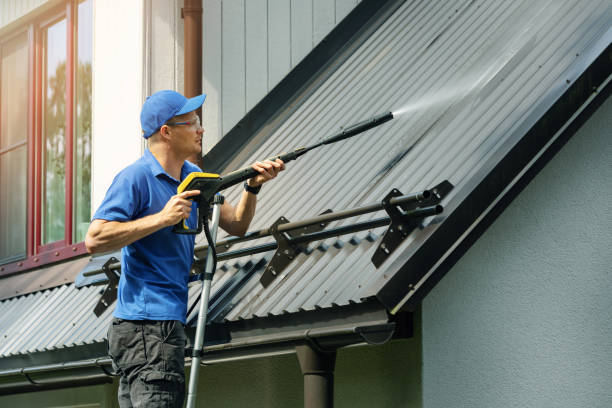Maintaining the exterior of your home is essential for both aesthetic appeal and the long-term health of the structure. One popular method for cleaning the outside of a house is pressure washing. This powerful technique uses high-pressure water to remove dirt, grime, mould, and other contaminants from surfaces.
While pressure washing can be highly effective, it’s important to consider both the benefits and potential drawbacks before undertaking this task. In this article, we will explore the pros and cons of pressure washing your house. check over here.

The Pros of Pressure Washing
1. Efficient Cleaning
Pressure washing is undeniably efficient. The high-pressure stream of water can quickly and effectively remove years of built-up dirt and grime from various surfaces. This can save you a significant amount of time and effort compared to manual scrubbing.
2. Versatility
Pressure washers come with various nozzle attachments, allowing you to adjust the pressure and spray pattern according to the specific surface you are cleaning. This versatility makes it suitable for cleaning a wide range of materials, including concrete, brick, wood, and vinyl siding.
3. Restores Curb Appeal
Over time, homes can accumulate unsightly stains from mould, mildew, and algae. Pressure washing can restore your home’s exterior to its former glory, improving curb appeal and potentially increasing its market value.
4. Preparation for Painting
If you plan to repaint your home’s exterior, pressure washing is an excellent preparatory step. It ensures that the surface is clean and free of contaminants, allowing the paint to adhere properly and resulting in a longer-lasting finish.
5. Environmental Benefits
Pressure washing eliminates the need for harsh chemicals, which are often used in traditional cleaning methods. This makes it an eco-friendly option for cleaning the exterior of your home.
The Cons of Pressure Washing
1. Risk of Damage
One of the most significant drawbacks of pressure washing is the potential for damage. If the pressure is too high or the nozzle is too close to the surface, it can strip paint, erode wood, or even damage softer materials like stucco. It’s crucial to use the appropriate pressure settings and maintain a safe distance from the surface.
2. Water Intrusion
Pressure washing can force water into areas of your home where it shouldn’t be, such as behind siding or window and door frames. This can lead to moisture-related issues like mould growth, rot, and structural damage.
3. Potential for Injury
Operating a pressure washer can be physically demanding, and if not used correctly, it can lead to injuries. The high-pressure stream of water can cause lacerations, bruises, and even more severe injuries. It’s important to follow safety guidelines and wear appropriate protective gear.
4. Dislodging Loose Materials
If there are already loose or deteriorating materials on the surface, pressure washing can potentially dislodge them. This can lead to further damage or the need for additional repairs.
5. Limited Effectiveness on Certain Surfaces
While pressure washing is highly effective on hard surfaces like concrete and brick, it may not be suitable for more delicate materials or surfaces that have already suffered significant damage.
Best Practices For Pressure Washing
To maximize the benefits of pressure washing while minimizing the risks, consider the following best practices:
- Choose the Right Equipment: Select a pressure washer with an appropriate level of power for the job. Lower-powered models are suitable for lighter tasks, while higher-powered ones are better for more substantial cleaning projects.
- Use the Correct Nozzle: Different nozzles provide varying levels of pressure and spray patterns. Choose the nozzle that is best suited for the surface you are cleaning.
- Maintain a Safe Distance: Keep the nozzle a safe distance from the surface to avoid causing damage. Start with a wider spray pattern and move closer if necessary.
- Test in an Inconspicuous Area: Before pressure washing an entire surface, test a small, inconspicuous area to ensure that the pressure is appropriate and won’t cause damage.
- Protect Surrounding Areas: Cover plants, electrical outlets, and other sensitive areas to prevent damage from the high-pressure water.
What Is The Best Pressure To Wash A House?
The optimal pressure for washing a house depends on the type of surface you are cleaning. Here are some general guidelines:
- Vinyl Siding: Use low pressure, typically between 1,200 to 1,500 pounds per square inch (PSI). Be cautious not to use too much force, as high pressure can cause damage.
- Wood Siding: Use low to medium pressure, around 1,200 to 2,500 PSI. Keep the nozzle at a safe distance to avoid splintering or damage to the wood.
- Brick: You can use higher pressure, around 2,500 to 3,000 PSI, but be careful not to get too close, as this can chip or damage the brick.
- Concrete or Masonry: Higher pressure is suitable, ranging from 2,500 to 3,000 PSI. Be cautious near edges or corners, as the force can wear away the surface.
- Stucco: Use low pressure, around 1,500 PSI or lower. Stucco is a delicate material and can be easily damaged by high pressure.
- Metal Surfaces: You can use medium pressure, around 1,500 to 2,500 PSI. Be cautious around painted or delicate metal surfaces, as high pressure can strip paint or cause damage.
Remember, the angle of the spray nozzle is also crucial. Start with a wider spray pattern and gradually narrow it down as needed. Always test in an inconspicuous area first to ensure that the pressure is appropriate and won’t cause damage.
It’s important to approach pressure washing with care and, when in doubt, consult the manufacturer’s recommendations for the surface you are cleaning.
Additionally, if you’re uncertain about the appropriate pressure, consider seeking advice from a professional pressure washing service. They have the experience and expertise to safely clean various surfaces without causing damage.
Conclusion
Pressure washing can be a highly effective method for cleaning the exterior of your home, but it’s essential to approach it with caution. By understanding the benefits and potential risks, and by following best practices, you can achieve excellent results while minimizing the likelihood of damage.
If you’re unsure about pressure washing your home, consider consulting a professional who can provide expert guidance tailored to your specific situation. With proper care and attention, pressure washing can help maintain the beauty and integrity of your home for years to come.
